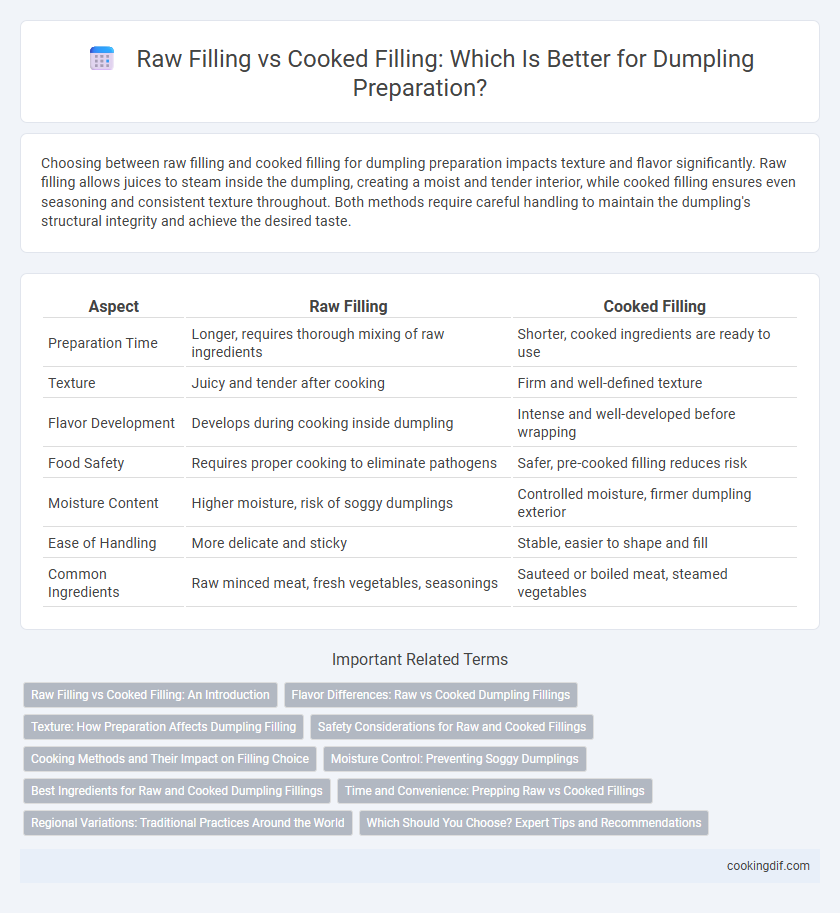Choosing between raw filling and cooked filling for dumpling preparation impacts texture and flavor significantly. Raw filling allows juices to steam inside the dumpling, creating a moist and tender interior, while cooked filling ensures even seasoning and consistent texture throughout. Both methods require careful handling to maintain the dumpling's structural integrity and achieve the desired taste.
Table of Comparison
| Aspect | Raw Filling | Cooked Filling |
|---|---|---|
| Preparation Time | Longer, requires thorough mixing of raw ingredients | Shorter, cooked ingredients are ready to use |
| Texture | Juicy and tender after cooking | Firm and well-defined texture |
| Flavor Development | Develops during cooking inside dumpling | Intense and well-developed before wrapping |
| Food Safety | Requires proper cooking to eliminate pathogens | Safer, pre-cooked filling reduces risk |
| Moisture Content | Higher moisture, risk of soggy dumplings | Controlled moisture, firmer dumpling exterior |
| Ease of Handling | More delicate and sticky | Stable, easier to shape and fill |
| Common Ingredients | Raw minced meat, fresh vegetables, seasonings | Sauteed or boiled meat, steamed vegetables |
Raw Filling vs Cooked Filling: An Introduction
Raw filling for dumplings retains moisture and melds flavors during steaming or boiling, resulting in a juicy texture and fresh taste. Cooked filling offers precise control over seasoning and texture, reducing the risk of undercooked meat and enabling firmer, more uniform consistency. Both methods impact cooking time, safety, and the final flavor profile, influencing dumpling preparation preferences.
Flavor Differences: Raw vs Cooked Dumpling Fillings
Raw dumpling fillings retain a fresher, more vibrant flavor, allowing the natural juices and spices to infuse the dough during cooking. Cooked fillings offer a deeper, richer taste due to the Maillard reaction and caramelization that develop complex savory notes before wrapping. Choosing between raw and cooked fillings influences the texture and intensity of aroma, significantly impacting the overall flavor profile of the dumpling.
Texture: How Preparation Affects Dumpling Filling
Raw filling preserves the freshness and natural moisture of ingredients, resulting in a juicier texture after steaming or boiling. Cooked filling offers a firmer consistency, as the ingredients are pre-softened and flavors melded during sauteing or simmering. The choice between raw and cooked fillings significantly influences the dumpling's final mouthfeel and structural integrity.
Safety Considerations for Raw and Cooked Fillings
Raw filling for dumplings requires thorough cooking to an internal temperature of at least 165degF (74degC) to eliminate harmful bacteria like Salmonella and E. coli, ensuring food safety. Cooked filling reduces contamination risks during preparation but must be handled carefully to prevent post-cooking contamination and stored below 40degF (4degC) to inhibit bacterial growth. Proper hygiene, timely cooking, and safe storage protocols are critical for both raw and cooked fillings to maintain dumpling safety.
Cooking Methods and Their Impact on Filling Choice
Raw filling for dumplings typically involves a mixture of fresh ingredients like minced meat, vegetables, and seasonings that cook fully during boiling, steaming, or pan-frying. Cooked filling, often prepared by pre-cooking ingredients such as sauteed vegetables or braised meats, allows for more complex flavors and a firmer texture that holds up well during frying or baking. The choice between raw and cooked filling significantly influences cooking methods, with raw fillings favoring steam or boil techniques for even cooking, while cooked fillings suit frying or baking methods that enhance texture and flavor depth.
Moisture Control: Preventing Soggy Dumplings
Raw filling in dumplings retains high moisture, requiring careful seasoning and starch binding to prevent sogginess during cooking. Cooked filling allows better control over moisture levels through pre-cooking techniques like sauteing or boiling, reducing water release inside the dumpling wrapper. Optimizing moisture content in both raw and cooked fillings is essential for maintaining a firm, non-soggy texture and ensuring dumplings hold their shape.
Best Ingredients for Raw and Cooked Dumpling Fillings
Raw dumpling fillings often feature finely minced pork, beef, or chicken mixed with fresh vegetables like Napa cabbage, scallions, and ginger to ensure tender texture and enhanced flavor after steaming or boiling. Cooked fillings typically incorporate pre-cooked ingredients such as sauteed mushrooms, caramelized onions, or braised pork, which deliver deeper umami profiles and reduce moisture content for sturdy wrappers during pan-frying or steaming. Incorporating moisture-absorbing binders like tofu or egg white in raw fillings and using oil or starch-thickened cooked fillings enhances overall dumpling integrity and taste.
Time and Convenience: Prepping Raw vs Cooked Fillings
Preparing raw filling for dumplings saves time by combining fresh ingredients directly, allowing flavors to meld during cooking, but requires careful handling to ensure thorough cooking. Cooked fillings offer convenience with pre-seasoned ingredients that shorten assembly time and reduce risk of undercooked centers, ideal for quicker meal prep. Choosing between raw and cooked fillings depends on balancing time efficiency with desired flavor development and food safety considerations.
Regional Variations: Traditional Practices Around the World
Raw filling dumplings, common in Chinese and Korean cuisines, rely on thin wrappers and quick steaming to cook meat and vegetables inside, preserving moisture and blending flavors during preparation. Cooked filling dumplings, favored in Russian pelmeni and Italian ravioli, use pre-cooked meat, mushrooms, or cheeses to ensure consistent texture and intensify savory notes. Regional variations reflect ingredient availability and culinary traditions, shaping distinct dumpling experiences across Asia, Europe, and beyond.
Which Should You Choose? Expert Tips and Recommendations
Choosing between raw and cooked filling for dumplings depends on texture preference and cooking method; raw fillings often result in juicier interiors as they cook inside the dumpling, while cooked fillings offer consistent flavor and reduced risk of undercooking. Experts recommend raw fillings for steaming or boiling to retain moisture, and cooked fillings when pan-frying to ensure thorough cooking without sogginess. For balanced taste and safety, combining partially cooked ingredients with raw components can optimize both flavor and texture.
Raw filling vs Cooked filling for dumpling prep Infographic

 cookingdif.com
cookingdif.com